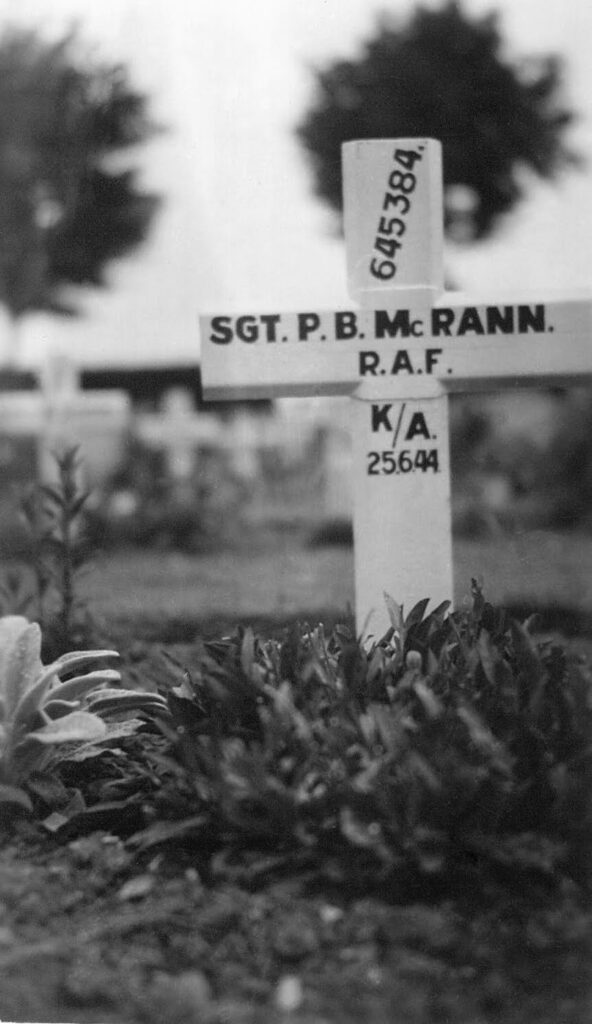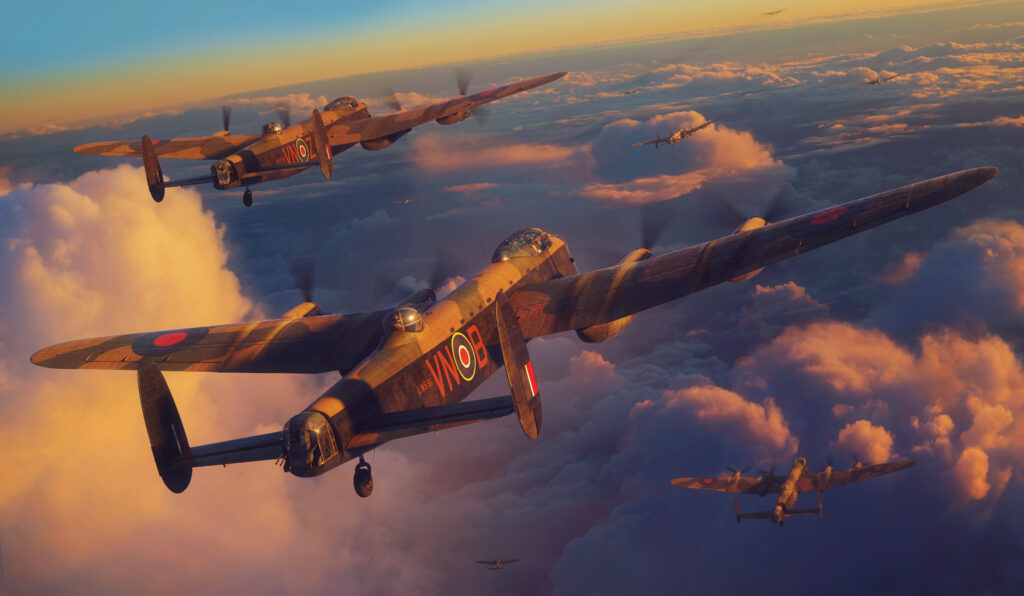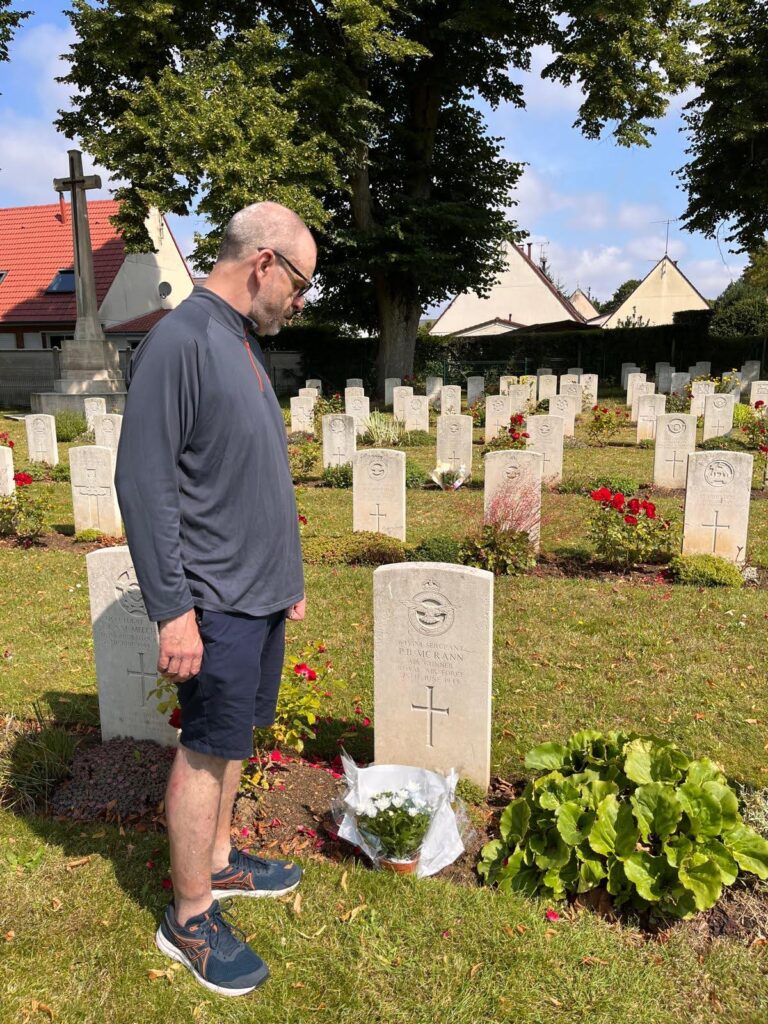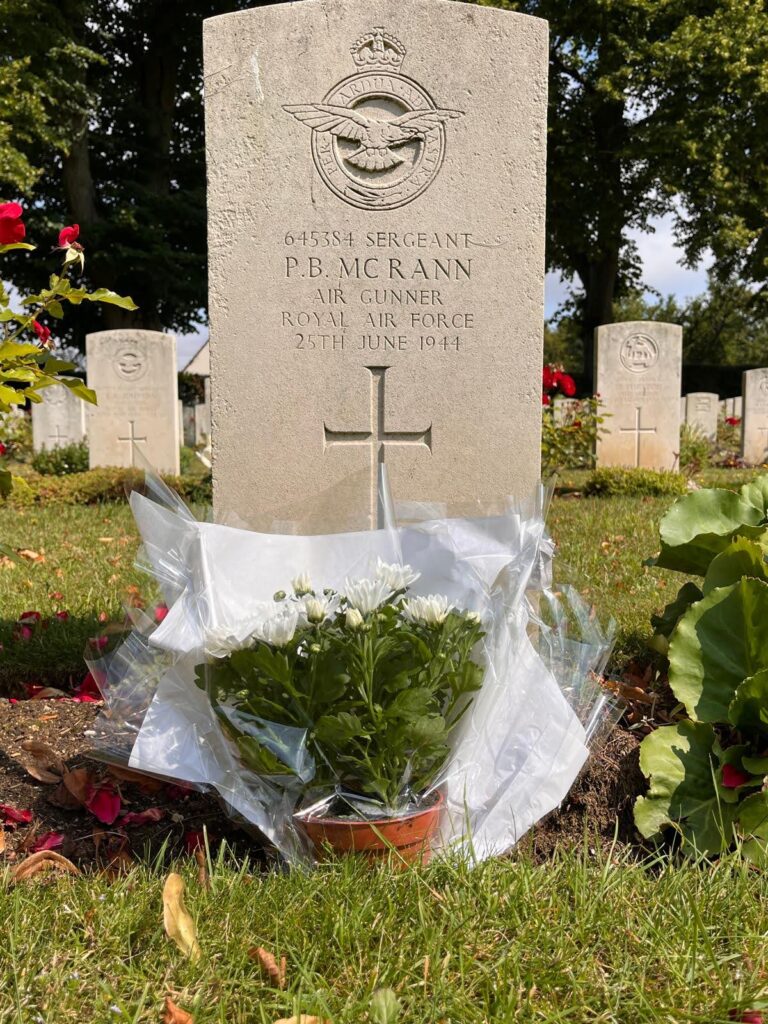By Desmond Gibney

This story begins with a photograph of a grave-marker bearing the name of RAF Sergeant P.B. McRann (below), found among the photos belonging to my late mother, Teresa Gibney (née McRann), over ten years ago. As the grave-marker had a number, 645384, a Google search revealed this to be the grave of a Sergeant Peter Brendon McRann in Plot 4, Row C, Grave 11, in the Commonwealth War Graves Commission (CWGC) plot of St Pierre Cemetery in Amiens, France. (The spelling of his middle name as ‘Brendon’ may have been an error in transcription from handwritten details on his birth certificate.) This is the story of the efforts of Sergeant McRann’s mother, Elizabeth McRann (wife of my mother’s Uncle Peter), to find out what happened to her son, as revealed through her correspondence with the Royal Air Force (RAF). I don’t recall Sergeant McRann ever being mentioned within the family, but I do remember hearing about a different Peter McRann, who served in the Royal Irish Constabulary (RIC) from 1907 until the force was disbanded in 1922. Researching this story has revealed that RAF Sergeant Peter McRann was the son of my mother’s uncle, RIC Constable Peter McRann.
JOINED THE RAF
Peter Brendan McRann, the fourth son of Peter and Elizabeth (née Ramsey), was born in Athlone on 7 June 1921. He joined the RAF on 23 May 1939, two weeks before his eighteenth birthday and three months before the start of the Second World War. At that time the family home was on Castle Avenue in Clontarf, Dublin. Over the course of the next four years, Peter Brendan was promoted to Aircraftsman Second Class, then Aircraftsman First Class and finally Temporary Sergeant. Despite the name, a Temporary rank could be held for quite some time, and this was common in wartime. Two of his older brothers also served in the RAF and were awarded the British Empire Medal (Military Division), and a sister served with the Women’s Auxiliary Air Force (WAAF).
The final phase of Sergeant McRann’s RAF service was spent with No. 50 Squadron, part of Bomber Command, and he crewed Lancaster bombers based at RAF Skellingthorpe in Lincolnshire. The Lancasters carried out daring missions, including the ‘Dambusters’ raids, during the Second World War, with a crew of seven (or sometimes eight), each of whom had to play their part to stay alive. The Lancaster has been described as ‘one of the most dangerous places to be in the entire war—the life expectancy of a new recruit was just two weeks’.

JUNE 1944 AND BOMBING ATTACK ON PROUVILLE
June 1944 was described by Chris Ward, a historian of No. 50 Squadron, as ‘a hectic month which would make great demands on the crews’, not least because of D-Day in early June. On the night of 24/25 June 1944, seventeen Lancaster bombers took off from Skellingthorpe as part of an attack on V1 flying bomb (winged bombs powered by a jet engine) launch sites in Prouville, France. ME798, containing a crew of seven, was one of two bombers reported missing. The context is described by Chris Ward:
‘The impression was of a somewhat haphazard attack that lacked concentration … ME798 was in the vicinity of the aiming-point when hit by fire from a night-fighter, which detonated the bomb load and distributed the Lancaster over a wide area, killing the experienced Pilot Officer Wood and his crew.’
Investigations by the Missing Research and Enquiry Service (MRES) in October 1945 established that ME798 crashed at La Mare Bossu near Hardinval on the road to Macquefer at 02:00 on 25 June 1944, and the crew were buried by German forces in the St Pierre military cemetery as ‘Officer Wood and 6 Unknowns’.
After making a freedom of information request to the UK Ministry of Defence, I received 70 pages of documents for Sergeant McRann, with only minor redactions of sensitive details. A report from the Wing Commander, Commanding, No. 50 Squadron, to the Under Secretary of State, Air Ministry, dated 25 June 1944, stated that ‘nothing further has been heard of ME798 since the time of take-off and its failure to return must be attributed to enemy action’, and listed the names of the seven crew as ‘missing’. A letter dated 30 June 1944 was sent to Sergeant McRann’s father to say that his son was missing: ‘this does not necessarily mean that he is killed or wounded, and if he is a prisoner of war he should be able to communicate with you in due course’ and enquiries were being made through the Red Cross. The letter concluded: ‘if any information regarding your son is received by you from any source you are requested to be kind enough to communicate it immediately to the Air Ministry’. Sergeant McRann’s mother replied on 18 July 1944, and thereafter all communications were between her and the military authorities. Her letter noted ‘How I looked forward to him coming home’ and stated that she had two other sons serving overseas with the RAF and a daughter serving with the WAAF. Her letter concluded that she was ‘hoping and praying for good news soon’.
‘A VERY POOR RETURN FOR OUR LOYALTY’
Mrs McRann was informed in a letter dated 16 November 1944 that ‘all efforts to trace your son … have proved unavailing’, and ‘in view of the absence of news for so long a period, it is felt that you should be informed of this Department’s grave anxiety for his safety’. However, ‘action to presume that he has lost his life’ would ‘not be taken until this Department has communicated with you further’. On 3 April 1945 Mrs McRann was informed that, owing to the lapse of time and lack of any news, ‘the Department now propose to presume his death for official purposes’, but before that would be done she was requested ‘formally to confirm that you have received no evidence of his survival’. Mrs McRann replied on 11 April 1945, confirming that her last letter received from her son was in May 1944; she again mentioned her two sons and daughter serving with the RAF and WAAF, and said ‘I think it a very poor return for our loyalty; what are the Red Cross doing that they can’t find out what happened’.
On 18 June 1945 Mrs McRann wrote that ‘it would be a great comfort to know if any of his crew were found living’, as ‘not knowing his fate is a great strain’; she had ‘got an idea he was taken prisoner and murdered by the fiends’ and concluded with the words ‘Long live England’. A reply dated 26 June 1945 assured her that her fear that her son ‘was murdered whilst a prisoner of war is quite unfounded’, as his name was not on any list of captured RAF personnel furnished to the Red Cross, and also acknowledged ‘the anxiety which waiting for news must cause you, and regrets most deeply that such news if obtained, can but add to the sadness of your great loss’.
The family’s quest for more information persisted. On 25 June 1946, the second anniversary of Sergeant McRann’s death, a notice in the Roll of Honour section of the family notices of the Irish Times described him as ‘missing, presumed killed’ in France, with ‘any information gratefully received. English papers, please copy.’ The graves in St Pierre Cemetery were exhumed in September 1946 in order to positively identify each of the seven crew of ME798; the Air Ministry was informed on 27 November 1946 of the positive identification of the remains.
Mrs McRann was not notified of this positive identification of her son’s remains until 24 February 1947. She replied on 1 March 1947 to say that Peter Brendan’s ‘expressed desire should he be killed on air operations or by accident, he should be buried with his brother and his life companion’. This is a reference to his brother, Patrick James, who died at the age of six in 1920, the year before Peter Brendan was born. Mrs McRann asked whether it would ‘be possible now to have his remains exhumed and sent to Dublin’, but she was informed by a letter dated 22 March 1947 that repatriation of the remains was not possible owing to the British government’s decision that ‘the bodies of those members of the forces who are buried overseas shall not be returned to their homelands for burial, but that their graves shall be maintained in perpetuity by the Imperial War Graves Commission’.
FINAL LETTER FROM SERGEANT McRANN’S MOTHER

Mrs McRann’s final letter, dated 11 April 1947, asked whether it would be ‘possible to have a photo of my son’s grave at least or could I have a wreath placed on his grave at the family’s expense’. A response dated 28 April 1947 stated that the Graves Service intended to photograph all of the graves when they have been suitably marked, and ‘as soon as the photograph of your son’s grave is received it will be sent to you. It is regretted that no facilities exist for the placing of wreaths on graves at the expense of next of kin.’ (Presumably that promise was kept and is the origin of the black-and-white photo of Sergeant McRann’s grave-marker (p. 44) found amongst my mother’s effects and possibly inherited from her aunt by marriage, Elizabeth McRann.)
The grounds of St John the Baptist Church on Seafield Road West in Clontarf contain a stone Celtic cross war memorial, commemorating losses in the First and Second World Wars. Mrs McRann wasn’t granted a mother’s wish that her son’s remains would be repatriated for burial in Dublin, but Sergeant P.B. McRann’s name is included on this Celtic cross. I visited St Pierre Cemetery in Amiens in July 2024, where Sergeant McRann is buried in the CWGC plot, beside the other six ME798 crew. Thinking of Mrs McRann’s final letter and her wish to have a wreath placed on her son’s grave, while also thinking that I may have been the first relative to have visited his final resting-place, I placed some flowers on the grave.
Desmond Gibney is an Assistant Professor at the National College of Ireland.
Further reading
R. Doherty, Irish men and women in the Second World War (Dublin, 2021).
J. Grenham, Tracing your Irish ancestors (Dublin, 2019).
W. Spencer, Air force records: a guide for family historians (Kew, 2008).
C. Ward, RAF Bomber Command profiles: 50 Squadron (Merthyr Tydfil, 2020).

